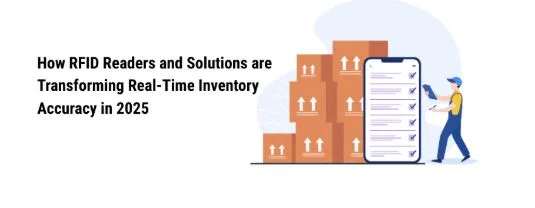RFID Readers and Solutions Are Transforming Real-Time Inventory Accuracy in 2025
In the fast-paced world of logistics and inventory management, accuracy and efficiency are paramount. As we approach 2025, RFID solutions are rapidly evolving, offering businesses the ability to track inventory with unprecedented precision and in real time. RFID readers, particularly high-performance RFID readers, are playing a central role in this transformation, reshaping how companies manage their stock and streamline operations.
The Evolution of RFID Technology
Radio Frequency Identification (RFID) has been around for decades, but its use in inventory management has surged in recent years. In 2025, RFID solutions are significantly more advanced than they were a few years ago, offering faster, more accurate, and more scalable options for businesses of all sizes. RFID technology is no longer just about tagging products; it’s about creating an integrated, data-driven ecosystem that provides businesses with actionable insights in real time.
Real-Time Inventory Tracking: The Key Advantage
The core benefit of RFID solutions lies in their ability to provide real-time visibility into inventory levels. Traditional barcode systems required manual scanning, which could be time-consuming and prone to human error. With RFID, high-performance RFID readers allow companies to scan multiple items simultaneously from a distance, providing an instant and accurate snapshot of their stock without having to stop and scan each item individually.
This means businesses can track inventory movements in real time — whether that’s on the warehouse floor or in transit. Real-time data ensures that companies always have accurate, up-to-date information on their stock, preventing issues like overstocking, stockouts, and misplacements.
High-Performance RFID Readers: Powering Accuracy and Speed
In 2025, the development of high-performance RFID readers has dramatically improved inventory accuracy. These readers have become faster, more reliable, and more efficient at scanning items, even in challenging environments such as large warehouses or areas with interference.
Unlike traditional RFID readers, high-performance RFID readers can handle large volumes of data in a fraction of the time. For example, a single high-performance RFID reader can scan thousands of tags within seconds, giving businesses an up-to-the-minute understanding of stock levels. This is especially important in industries with fast-moving inventory, such as retail or e-commerce, where even a small error in inventory can lead to significant disruptions in the supply chain.
Enhancing Operational Efficiency and Reducing Costs
With RFID solutions, businesses no longer need to rely on manual stock counts or periodic audits to maintain inventory accuracy. The ability to track items in real time significantly reduces labor costs associated with inventory management. Instead of sending workers to physically count stock, RFID technology allows for continuous, automated tracking.
Moreover, the efficiency of high-performance RFID readers enables quicker replenishment cycles. As inventory levels are automatically updated, companies can trigger automatic reordering processes, ensuring stock levels are always optimized. This leads to better cash flow management, reduced storage costs, and fewer lost sales due to stockouts.
Improving Supply Chain Transparency
The integration of RFID solutions into the supply chain provides greater transparency and accountability. With real-time tracking, businesses can trace the journey of a product from the manufacturer to the warehouse and, ultimately, to the consumer. This transparency improves customer satisfaction, as customers can get accurate updates on their order status.
Additionally, RFID data can be used to optimize routes and reduce delivery times. For instance, by tracking shipments in real time, companies can identify bottlenecks in the supply chain and take proactive steps to alleviate delays.
Future-Proofing with RFID Technology
As we move deeper into 2025, the future of RFID solutions looks even more promising. The technology is expected to become more integrated with other advanced systems, such as IoT (Internet of Things) and AI, to provide even more intelligent insights into inventory and supply chain performance.
For example, combining high-performance RFID readers with AI can allow for predictive analytics, helping businesses forecast demand and inventory needs with higher accuracy. This type of smart, connected infrastructure will enable businesses to stay ahead of the competition by making more informed, data-driven decisions.
Final Thoughts
RFID solutions are transforming real-time inventory accuracy in ways that were once unimaginable. The introduction of high-performance RFID readers has revolutionized how businesses track, manage, and optimize their inventory, improving operational efficiency and reducing costs. As the technology continues to evolve in 2025 and beyond, it will only become more essential for businesses looking to stay competitive in an increasingly data-driven world.
By leveraging RFID technology, businesses can create smarter, more efficient inventory management systems that lead to better decision-making, improved customer satisfaction, and optimized supply chain operations.




